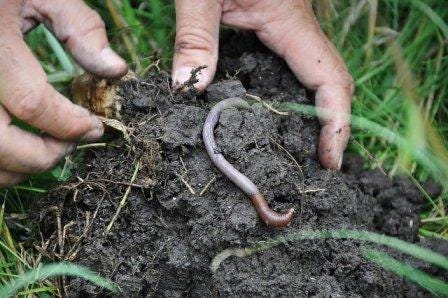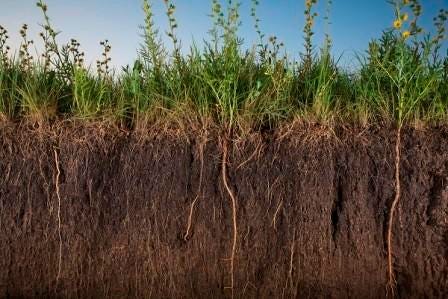Welcome to Terra Firma by Courtney White. I’ve spent my life prospecting for innovative, practical, and collaborative answers to pressing problems involving land and people, sharing them with others. I’d like to share them with you!
Don’t miss the next issue, sign up here:
News Item: Here’s a December 31st article from Outside magazine about regenerative agriculture hitting the mainstream. A quote: “Whole Foods says it’s the number-one food trend of next year. Patagonia has made it a centerpiece of its activism and will be rolling out products made using the practice early next year. General Mills announced that it will employ regenerative agriculture on one million acres.” (see) Here is the link to Whole Foods’ predictions for 2020: (see)
In the previous issue of Terra Firma, I discussed an ‘out there’ idea I had in 2010 called a ‘carbon ranch’ which was inspired by the work of the Marin Carbon Project in California. It built on the idea that carbon is the essential element in our lives (TF#5) and when coupled with progressive land management practices, such as no-till farming (TF#2) it could have a huge impact on the world.
In this issue, I’d like to review legislation passed recently involving healthy soils – policy prospects that would have been impossible even six years ago. It’s another important sign that soil carbon and regeneration have shifted from the edge to the mainstream and became a movement. Hopeful news indeed!

It began at the pivotal UN climate summit in Paris in 2015 (COP21), which I had the honor of attending on the behalf of the Quivira Coalition and Regeneration International as an observer. As you will recall, in an effort to slow climate change delegates from 197 nations negotiated and then signed a landmark Agreement committing their governments to reductions in greenhouse gas emissions starting in 2020 (alas, recent events have undercut the Agreement’s prospects).
This was big news at the time, but there was another important development that did not make headlines. It occurred on December 1st when the French government launched a plan to improve food security and fight climate change with soil carbon called the ‘4 For 1000 Initiative’ – a number that refers to a targeted annual growth rate of soil carbon stocks. “Supported by solid scientific documentation, this initiative invites all partners to state or implement some practical actions on soil carbon storage and the type of practices to achieve this.” (see)
These practices include the use of cover crops, perennial plants, no-till farming, and livestock grazing patterns that mimic nature. If managed properly, these nature-based practices not only increase soil carbon levels they can dramatically reduce the amount of greenhouse gases produced by agriculture.
These practices can also increase ecological and economic resilience to climate change. In an op-ed published three days after the French announcement, author Michael Pollan and Deborah Barker, of the Center for Food Safety, wrote “Regenerative farming would also increase the fertility of the land, making it more productive and better able to absorb and hold water, a critical function especially in times of climate-related floods and droughts. Carbon-rich fields require less synthetic nitrogen fertilizer and generate more productive crops, cutting farmer expenses.” (see)
Best of all, regenerative agriculture was acknowledged as a shovel-ready solution to climate change. That’s a big reason why over one hundred nations, NGOs, and agricultural organizations signed onto the original ‘4 For 1000 Initiative’. “[It] has become a global initiative,” said French Agriculture Minister Stéphane Le Foll. “We need to mobilize even more stakeholders in a transition to achieve both food security and climate mitigation thanks to agriculture.”
The soil health movement was afoot! Here’s a photo I took of the Eiffel Tower hours after the climate Agreement was signed on December 12, 2015:

Since Paris, a number of legislative bills have been passed and signed into law around the nation giving momentum to the movement.
One of the first was California’s Senate Bill 859, signed into law by Governor Brown in 2016, which built on a greenhouse gas reduction law passed a decade earlier. It established a Healthy Soils Program within the Department of Food and Agriculture and defined health as “soils that enhance their continuing capacity to function as a biological system, increase soil organic matter, improve soil structure and water-and nutrient-holding capacity, and result in net long-term greenhouse gas benefits.”
Here’s the actual language from the bill, which set a precedent for other efforts:
Section 569. (a) (1) “The program shall seek to optimize climate benefits while supporting the economic viability of California agriculture by providing incentives, including, but not limited to, loans, grants, research, and technical assistance, and educational materials and outreach, to farmers whose management practices contribute to healthy soils and result in net long-term on-farm greenhouse gas benefits. The program may also include the funding of on-farm demonstration projects that further the goals of the program.” (see)
This text is important because it formalized in legislation (ie made mainstream) the roles of soil carbon and regenerative agriculture in fighting climate change and improving food security. In other words, what had been a far-out idea in 2010 was official state policy now – only six years later! It happened thanks to the dedicated effort of many people, including critical advocacy work by the California Climate & Agriculture Network (CalCAN), an inspiring nonprofit organization.
In 2019, the California the Department of Food and Agriculture selected 217 projects across the state for grant awards under the Healthy Soils Program, totaling $12.48 million dollars divided between direct incentives to farmers and ranchers and demonstration projects (see). Very cool!
Here is a photo of healthy soil from CalCAN’s Twitter account:

There have been a number of soil initiatives passed by legislatures around the country since 2016, including ones in Hawaii, Maryland, Washington, Illinois, Connecticut, Nebraska, Iowa, New York, Vermont, and Massachusetts (for a full list see Resources below). Not all of these bills address climate change or embrace the full suite of regenerative practices but they are significant in that they promote the benefits of healthy, carbon-rich soils – a huge departure from the traditional support for industrial agricultural practices.
In 2019, New Mexico (where I live) joined the wave with the passage and signing of the Healthy Soil Act, creating a program within the Dept. of Agriculture “to promote and support farming and ranching systems and other forms of land management that increase soil organic matter, aggregate stability, microbiology and water retention to improve the health, yield and profitability of the soils of the state.” The grant process is underway and the first awards will be made before the end of June!
Hopefully, more states (and eventually Congress) will join this exciting wave of initiatives that encourage soil health - on which all life on earth depends.
That’s what Terra Firma is all about: looking at the world in a positive way, grounded in nature, experience, facts, and hope.
Resources:
These articles summarize state-by-state healthy soils initiatives (most recent first):
Video:
A three-minute video on the 4 for 1000 Initiative from a global perspective. (see)
A one-minute video on California’s Healthy Soils Initiative featuring Karen Ross, CA Secretary of Food & Agriculture in 2017. (see)
A eleven-minute video via the Soil Health Institute/Tufts University surveying state programs in 2018. (see)
Organizations:
CalCAN: http://calclimateag.org/
Food Tank (a ‘Think Tank for Food’): https://foodtank.com/
4 For 1000: https://www.4p1000.org/

COURTNEY’S CORNER
~ Through on-the-ground experience over many years, I have come to believe there are five principle areas where effective, low-cost, nature-based answers to pressing challenges can be found, forming a basis for policy work. They are listed on my web site under the title Action: (see)
~ Latest book: Fibershed: Growing a Movement of Farmers, Fashion Activists, and Makers for a New Textile Economy by Rebecca Burgess and yours truly, 2019, https://www.chelseagreen.com/product/fibershed/
~ Here’s my pick for the Terra Firma photo of the week (credit unknown):

Thank you for reading this issue of my newsletter. It is published every Thursday morning – for free! Please consider sharing it with a friend or two or three:
About me: For twenty years I worked to create a radical center among ranchers, conservationists, agencies and others focused on western working landscapes. Today, I am a full-time writer. My nonfiction books include Forewords by Wendell Berry and Michael Pollan. For more information or to contact me visit: www.jcourtneywhite.com
I am also the author of a MYSTERY novel called The Sun. It is a modern-day story set on a working cattle ranch in northern New Mexico (see). To purchase a copy go here. Here’s an endorsement from Anne Hillerman, New York Times best-selling author of the Leaphorn/Chee/Manuelito mysteries:
“In this far-ranging debut novel, Courtney White creates a story worthy of his deep and detailed knowledge of the American West today. Nicely done!”
Terra Firma means ‘solid earth’ or ‘firm ground’ in contrast to air or water. Historically, it was first used by the Republic of Venice to describe its holdings on the Italian mainland.

